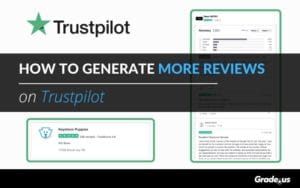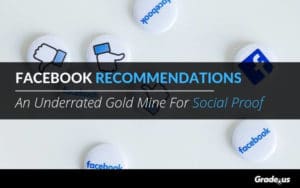Why are HomeAdvisor reviews so critical to attracting leads in the home services industry?
A Gallup poll found only 29% of consumers believed building contractors had “high or very high” honesty and ethics. Is this perception the truth for the vast majority of the industry?
Of course not.
Much of your customer’s apprehension stems from inexperience about the home remodel or improvement process or a poor experience. You can change that with HomeAdvisor, boosting your lead flow in as little as 45 days.
Here’s what we’ll cover today:
Table of Contents
The value of HomeAdvisor Reviews
HomeAdvisor got its start as Service Magic in 1998. They connect homeowners with prescreened home remodeling and improvement pros. Many pros offer this service; this isn’t unique to HomeAdvisor, so what makes them unique? Their merger with Angie’s List.
In October 2017, HomeAdvisor merged with Angie’s List to form ANGI Homeservices, trading on the NASDAQ as ANGI. This merger created the largest digital marketplace for home services.
This merger created a monopoly.
Ken Copley, analyst and portfolio manager with Capital Executive, had this to say about the merger —
“While there are many user-review websites, there are no other large-scale services that allow people to seamlessly sift through reviews and set up an appointment with a plumber or roofer.”
Here’s why this merger is meaningful.
Consumers rely primarily on review platforms to find professionals, and ANGI home services (via HomeAdvisor, Angie’s List, and nine other service brands) is the undisputed leader. This means you have access to a never-ending supply of customers.

Source: Statista
It’s a huge opportunity in the right hands, even if you’re not a believer in services like HomeAdvisor, here’s why.
- The “money” demographic — homeowners aged 35 to 54 rely on personal connections, friends, and family to find a contractor.
- Younger demographics rely on online review platforms like HomeAdvisor and Yelp to complete their search.
- 36% of both older and younger demographics looked for online reviews at some point during the sales process.
- 50% of homeowners trust information from review platforms like HomeAdvisor, Yelp, or Google Reviews.
- 46% relied on personal relationships to find the right home improvement professional.
- HomeAdvisor saw a 21% year-over-year revenue growth 279.5 million.
- 23 million service requests from 13 million households.
- 214,000 home remodeling and improvement pros on HomeAdvisor.
- HomeAdvisor produced an estimated 17 billion in transaction value for pros.
HomeAdvisor’s dominance is your gain. You have steady access to customers who are willing and able to buy.
HomeAdvisor is valuable for another important reason.
Google.
HomeAdvisor is highly visible in Google’s search results. Google’s local pack is displayed prominently for broad and generic searches (i.e., “home remodeling contractors Chicago”).

What about search results for specific businesses in local communities? Let’s take a look at DESIGNfirst Builders, a remodeling contractor based in Chicago, IL.

HomeAdvisor and Angie’s List merged, remember? This means that you have double the exposure across Google. This means your business has a tremendous reach on the HomeAdvisor platform.
This is very good news.
The anatomy of a HomeAdvisor Review Profile
Let’s take a look at the parts of a HomeAdvisor profile to see how we can use these reviews.
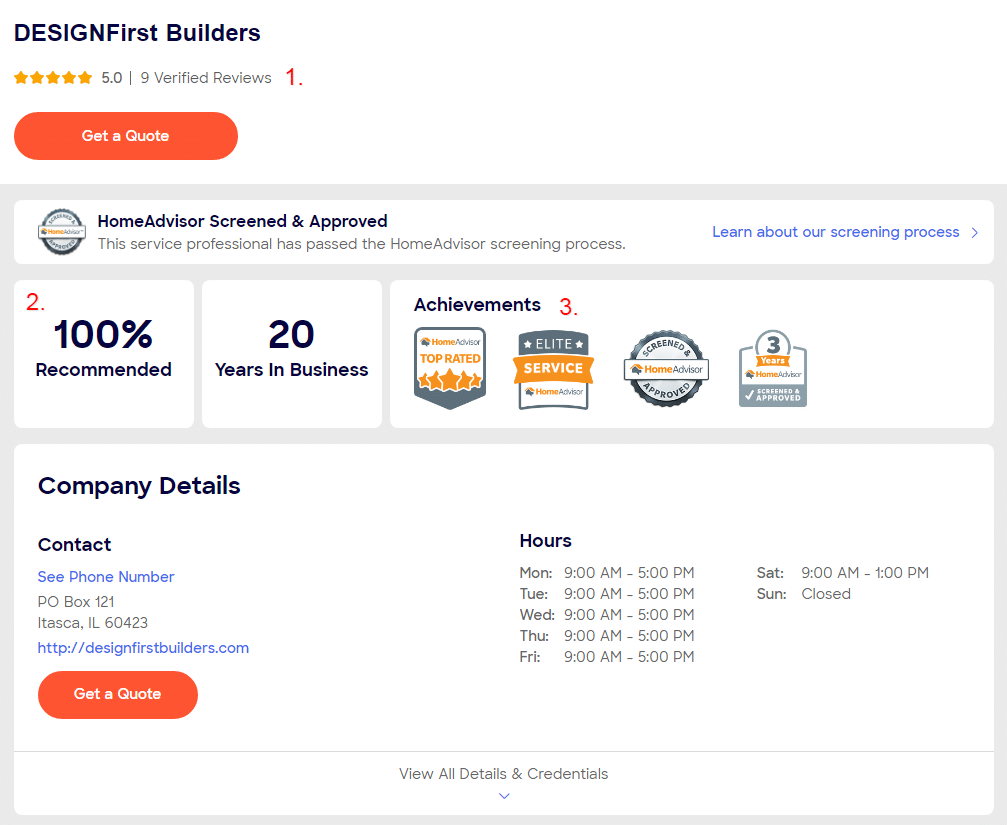
- Aggregate reviews and the total number of reviews
- The percentage of customers who recommend this particular business
- HomeAdvisor specific achievements and badges (e.g., top-rated, elite service, screened and approved, etc.)
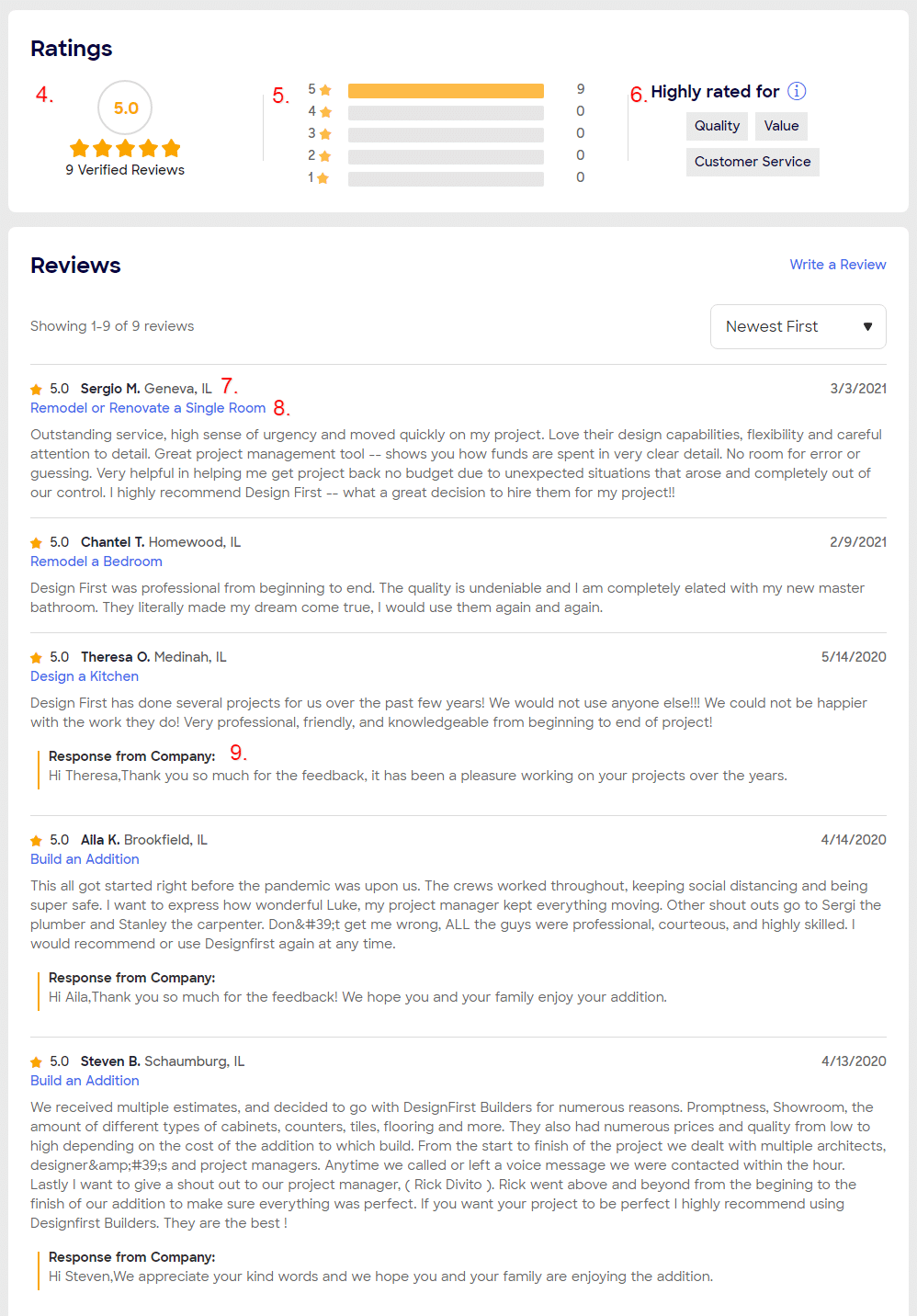
- The aggregate review ratings and the total number of reviews listed again
- The breakdown of reviews, by rating
- Attributes (tags) that outline what the company is known for in its reviews
- The number of stars listed, the name of the reviewer, and their location
- The work that was done. If you click on the work that’s done, you’re invited to request a quote
- The reviews from customers and the response from the company reviewed.
Who visits HomeAdvisor?
We can break HomeAdvisor users down into four groups — Millennials, Generation X, Baby Boomers, Silent Generation. Here’s how these groups approach home improvement on HomeAdvisor.
While other generations are firmly established financially, millennials have yet to recover from the great recession. According to HomeAdvisor:
“The generational gap in priorities is a dramatic example of the millennials’ current struggle to catch up financially with older generations. Even 10 years after the great recession, the generation that came of age during the collapse and slow recovery is trying hard to get its feet back on the ground.”
This plays a significant role in the research, shopping, and buying habits of millennials.
“These trends make sense: Millennials are consistently using multiple methods to research the costs at a higher level than other generations. In addition to wanting a higher return on their investments, millennials are price-sensitive consumers that have come into their adult lives in the midst of the great recession. They haven’t yet hit their peak earning power and have smaller houses than any other generational cohort (1% smaller than baby boomers, 5% smaller than the silent generation, and 6% smaller than Generation X).”
How does this contrast with shoppers in other generations?
“Millennials’ need for financial growth is manifesting itself not only in intergenerational differences in spending priorities, but also in methods of price and cost searching. Respondents report generational differences in their methods for researching home improvement costs, with Generation X and millennials preferring online and retail options. Baby boomers and the silent generation also used the internet, but they relied on previous contractors and retail options more evenly.”
What does this mean for your home improvement business? It isn’t enough to focus your attention on word-of-mouth. You’ll need to cater to each generation if you want to ensure that your business is successful.
What about after the sale?
You’ve just wowed customers; they’re pleased with the quality of your work and eager to work with you again. How do you get them to share their experience with other like-minded customers on HomeAdvisor?
How do you ask for HomeAdvisor Reviews?
“We provide customers with the ability to rate their experience working with you via Customer Ratings & Reviews. You will also have the ability to solicit and collect ratings and reviews from any of your customers, which may or may not be displayed in LiveDirectory (defined below), in HomeAdvisor’s sole discretion.”What does this mean?
- HomeAdvisor solicits reviews from customers on your behalf once a project is complete.
- You also have the opportunity to request reviews from customers once a project is complete.
- Choose a consistent team to manage your reviews (e.g., customer service, marketing, sales, etc.). Avoid mixing and matching or dividing up the roles across various departments.
- Choose the right time. If you want customers to remember what you did for them, it's best to make your request immediately after their project is complete. The closer your request is to the completion date, the easier it will be to earn their feedback.
- How to make your request. You can wait for HomeAdvisor to request a review on your behalf, sure. However, it's probably best to make the request yourself. You can request reviews via HomeAdvisor's Pro platform. That's great initially, but it's terrible in the long term as the numbers of customers coming to your business grow. A better option? Start with a tool like Grade.us that enables you to automate the process consistently over time.
That’s the thing with HomeAdvisor.
You can request reviews on their site directly, on your own (manually), or via a third-party tool like Grade.us. If you’re looking to start and grow quickly, you’ll want to invest in a tool that can automate the process for you and your team. If you’re just starting your business and you’re looking to grow slowly, working with HomeAdvisor’s platform directly may be a good fit.
How should you respond to HomeAdvisor Reviews?
HomeAdvisor reviews are a great way to build a strong local search profile. These reviews are a powerful way to generate search engine traffic when combined with reviews from other mainstream platforms. Here’s what HomeAdvisor has to say about reviews on their platform.
“Ratings & Reviews empower homeowners to make educated hiring decisions and help our member service professionals communicate the quality of their work. We pride ourselves on the integrity of our Rating & Review collection and authentication process. Learn more about how it works:
1. Homeowners can review any professional that is a member of HomeAdvisor.
2. A dedicated team follows up on reviews to determine authenticity.
3. All honest, objective feedback is posted – good or bad.
4. Professionals have the opportunity to respond to the reviews they receive.”
HomeAdvisor bases reviews on three criteria.
- Quality
- Customer Service
- Value for the money
They also ask customers to provide additional feedback on the pro they hired.
Here’s the thing about feedback.
HomeAdvisor has a resolution process in place for customer complaints. Here’s how they handle it.
“Your feedback is vital to the quality of service our member professionals provide. As with any credible grievance process, we first evaluate both sides of the story before making a final decision. Often, an unpleasant experience is the result of a simple misunderstanding between the two parties. However, if there is a negative trend against the service professional, we reserve the right to remove a service professional from our network.”
Believe it or not, this is good news.
HomeAdvisor is willing to work with you on behalf of the customer. This is an interesting departure from other review platforms like Yelp. Why is HomeAdvisor willing to give you the benefit of the doubt with customers when others won’t?
They’ll do this because you’re their money maker.
The service is free for customers to use, but it’s a paid service for pros. They need pros to survive, so their interests are somewhat aligned. What about responding to customer reviews? If you have a pro account, you can respond to customer reviews directly.
Okay then, how should you be responding to HomeAdvisor reviews?
First, you’ll want to identify who should be responding to your customer reviews. There are a few criteria you’ll want to adhere to in order to maximize the results you’re able to achieve.
- Again, you'll want to choose the team to manage your reviews (e.g., customer service, marketing, sales, etc.). If you're following best practices, the team that requests reviews is the team that responds to reviews.
- Assign roles to specific employees based on their skills, talents, and temperament (i.e., don't ask hotheads to respond to customer reviews).
- You'll also want to ensure you provide your employees with the training and educational resources they need to respond to customers properly.
Second, you’ll want to set a time to respond.
Research shows 52% of customers expect a response to their reviews within 7 days; 1 in 4 expect a response within 3 days, and 21% expect a response within 24 hours.
A better idea?
Work to respond to customer reviews within one business day, no later than 48 hours. This sends a clear message to customers and lurkers watching your business. It shows them that you care about their feedback and are willing to engage with them in a timely fashion.
It shows that you’re reliable.
This sounds impossible, and it is if you create a custom response for every review.
There’s a better way.
Create templates around common themes in customer reviews, then show your employees how to customize their responses around these themes, providing customers with the reaction they’re expecting.
Not sure where to start?
Here are some response templates you can use for negative and positive reviews.
Here’s an example.
Let’s say you’re a plumber and you’re dealing with an unhappy customer. They’ve posted a negative review, and you’re looking to make things right. Where do you start?
You acknowledge the problem.
[Name],
I’m sorry to hear that things didn’t go as smoothly. We want you to feel satisfied with the service you receive. Would you be willing to share more details with us on your issues? We’d like to [solution/offer].
Please call me directly at [Phone Number.]
Best,
[Signature]
[Title]
See the difference?
You’re acknowledging your customer’s feedback and looking for a way to fix/repair the relationship. You have a template you can customize. This makes responding to customer feedback at scale a simple and transparent process.
Marketing your HomeAdvisor Reviews
HomeAdvisor has lots of unhappy customers.
These are contractors who register for a pro account, pay their per-lead fee, and wait for results. What do they receive for their money?
Not much.
Many of these pros feel the platform was a raw deal for them.
There are some legitimate concerns regarding HomeAdvisor (i.e., creating profiles on third-party sites, then selling the leads to other customers). I’m not going to cover those details in this post. Instead, I’m going to focus on helping you double your lead flow in 45 days or less. First things first.
You need a HomeAdvisor profile, whether you’re buying leads from them or not.
Why?
There are two important reasons why a HomeAdvisor profile is a must-have.
- Angie’s List and HomeAdvisor’s strong presence in Google’s search results,
- Your competitors are present on both Angie’s List and HomeAdvisor. If you’re not, you’re losing market share in Google’s search results.
A strong review portfolio means you have profiles in HomeAdvisor, Yelp, Google Reviews, and various other review platforms.
Here’s why this is important.
The better you are at marketing and promoting the reviews you receive on your HomeAdvisor profile, the easier it will be to attract a large volume of quality leads for your home service business. How can you market and promote your reviews? You can use them in:
- Your website copy: This is an obvious slam dunk. Customers who arrive on your website are looking for education (that demonstrates expertise or knowledge) and information (reviews, awards, credibility markers, etc.).
- Promotional emails: Your reviews can be shared in both broadcast or autoresponder sequence emails. Your reviews can be used with both educational and informational content.
- Your social media posts: You can use/promote reviews as evergreen content on your social media profiles. They can be promoted immediately after completing a service call, added to customer objections about your service, or used as general content to attract and convert customers.
- Using them in Ads: Reviews are an effective way to drive traffic to your review portfolio, website, and lead pages. The great part about this is the fact that you're able to extend the life of individual customer reviews considerably.
If you decide to purchase leads from HomeAdvisor, it’s easier to convert customers with a strong review portfolio. What if you decide that HomeAdvisor is not for you and you choose to go your own way?
You’ll still need a strong review portfolio.
If you decide to run your own ad campaign, customers are still going to check for reviews. A strong review portfolio lowers your per lead cost, so it costs less money to attract more customers. It increases your return on investment and your return on ad spend.
If you decide to advertise on HomeAdvisor?
Here are some best practices you can follow to improve the results you receive.
- Pay for a yearly subscription to join HomeAdvisor Pro.
- Pay for individual leads. You’ll need to determine whether you want market match leads — leads that are shared with two other providers (three total). Or, exact match leads —leads that are sent exclusively to you.
- Set your spending target. This is the amount you’ll spend weekly on HomeAdvisor.
- Follow-up with leads immediately. This increases your chance of winning the job or at least the opportunity to bid on their project.
- Test the platform. If HomeAdvisor isn’t going to work for you, you’ll want to find out on the cheap.
- Use call tracking to verify the leads coming in from HomeAdvisor. This will give you the tools you need to confirm that the platform is consistently producing results.
- Keep categories that perform, dump categories that fail to produce a return.
What if you decide against HomeAdvisor? How can you use HomeAdvisor to produce the results you need?
- Use Paid ads via Google Ads, Facebook Ads, Bing Ads, or second-tier platforms to attract customers who are in the market for home improvement.
- Create landing pages that include the following ingredients: Maintaining ad scent, the customer’s problem, a solution (irresistible offer) customers can opt-in to receive (e.g., checklist, quiz, email, etc.) and social proof via embedded reviews from HomeAdvisor, Yelp, and other review platforms.
- Run A/B split tests to identify the landing pages that work best. You can use free tools like Google Optimize to test which landing pages or offers are working and which ones are not.
- Use Call tracking via platforms like CallRail to verify calls and customer contacts.
- Re-marketing to customers who’ve visited your site, with a combination of reviews + irresistible offers, deals, and incentives.
- Utilize email notifications that let you know, in real-time, when a lead comes in. This is your cue to reach out immediately to these customers.
Here’s how you double your lead flow.
You use a service like Answer the Public to identify all of the questions customers have on a particular topic. If we use a keyword like “HVAC,” here’s a list of the 155 most common questions.
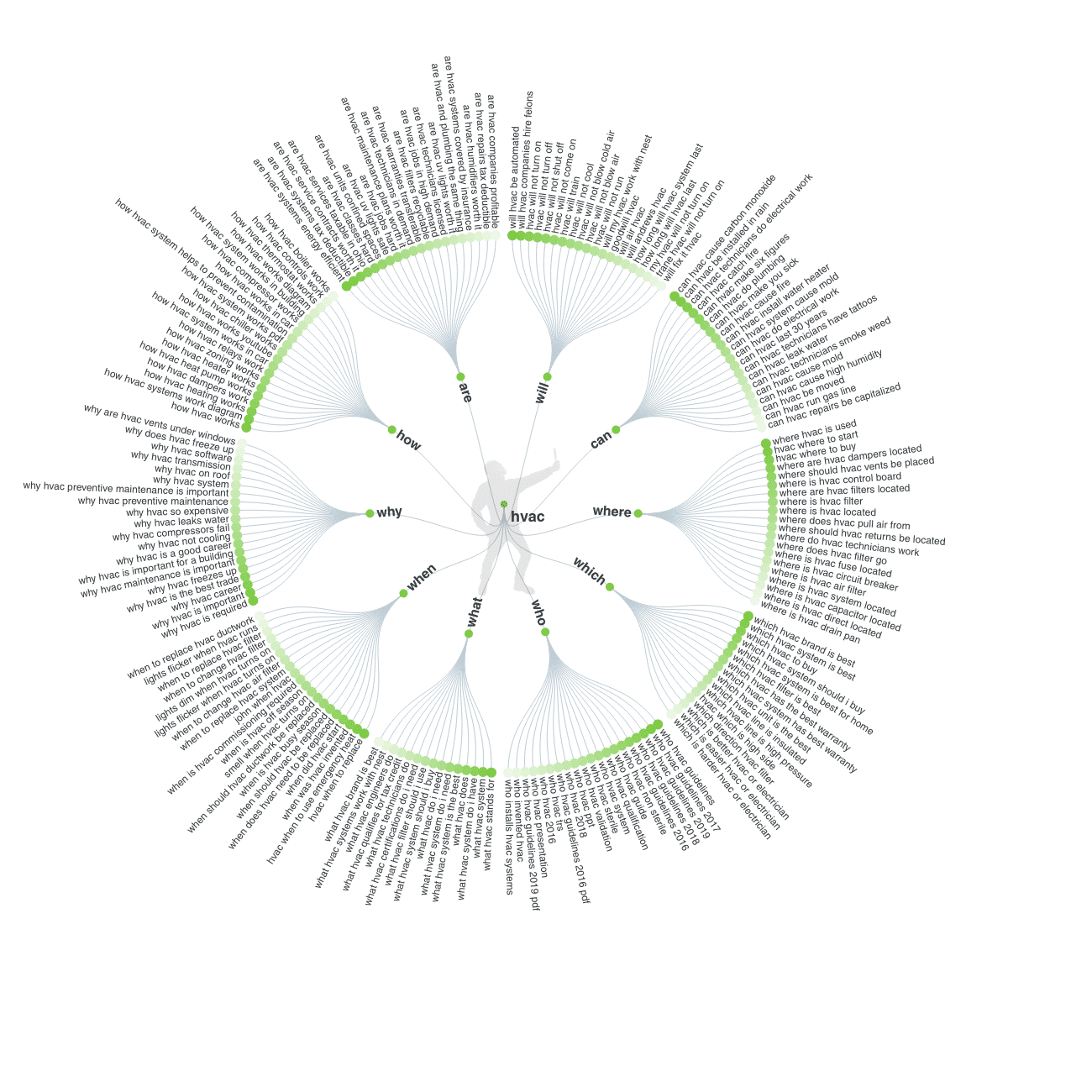
Next, turn these questions into content. You can do this by:
- Creating ads on Facebook or Google Ads that answer these questions.
- Finding and answering these questions on Q&A sites like Reddit, Quora, and Yahoo Answers.
- Creating and advertising workshops for a specific target audience (i.e., how HVAC and remodeling habits can increase investor profits by 37%).
- Partnering with tangential sources that serve the same audience you do but in a different way (i.e., HVAC, general contractors, plumbers, and electricians).
Combine these strategies with the strategies I mentioned, whether you’re working with HomeAdvisor or not. This is how you double your lead flow in 45 days.
Here’s the best part.
You can scale these strategies up or down, provided that you can handle the demand. If you want more leads, push a little harder. If you don’t want as many leads, you can let off the gas a bit.
HomeAdvisor can work hard for your business
But you need to lay the proper groundwork first.
The more credibility you have, the more competent you are, the more leads you receive. The more reviews you have across various review platforms, the easier it is to attract and win new customers.
Customers are apprehensive.
Their apprehension is based on their inexperience or poor experience, and their default is typically distrust. You can change this situation for the better.
You need competence, credibility, and social proof.
It’s a three-step formula you can use to win non-stop leads. Your customer’s perception isn’t reality. Content is the key to trustworthiness. With the right content, you can eliminate your customer’s apprehension about the home remodel or improvement process.
Give customers the competence they need, and you’ll find customer apprehension is largely a thing of the past.




